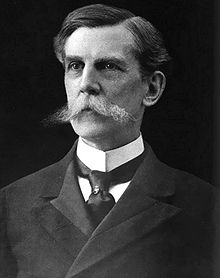User:GhostRiver/buck
Background
[edit]Eugenics in the United States
[edit]The movement in the United States to surgically prevent those deemed undesirable from reproduction began with Texas doctor Gideon Lincecum, who in 1849 authored a bill for the Texas Legislature that would have allowed criminals sentenced to execution to endure castration instead.[1] While Lincecum's bill was never passed, a number of violent criminals, mostly black Americans, were castrated from the 1860s to 1880s in states such as Texas, Kansas, Oregon, Indiana, Pennsylvania, and Illinois.[2] The concept of sterilizing criminals was expanded in 1888 with a paper by Orpheus Everts, the superintendent of the Cincinnati Sanitarium, who argued that the castration of individuals whose crimes were "constitutional depravities that are recognized as transmissible by heredity" would "eventuate in an effectual diminution of crime and reformation of criminals".[3]
Buck family
[edit]
Circuit and Appellate Court
[edit]Opinion of the Court
[edit]
Holmes's opinion
[edit]Associate Justice Oliver Wendell Holmes Jr. wrote a brief majority opinion, only five paragraphs and just under three printed pages long.[4][5]
Butler's dissent
[edit]The only Supreme Court justice to dissent in Buck v. Bell was Pierce Butler, who did not write a dissenting opinion.[6] His silent dissent was not uncommon in his tenure with the Supreme Court, but nevertheless makes the rationale behind his disagreement subject to interpretation, with most speculation focusing on either Butler's previous rulings on personal autonomy or on his Roman Catholic faith.[7] Butler's previous decisions in cases such as Meyer v. Nebraska and Pierce v. Society of Sisters had invoked the Due Process Clause in cases of personal privacy and autonomy. As such, it is possible that the forced sterilization at the center of Buck v. Bell was inconsistent with his expansive interpretation of the Fourteenth Amendment and individual liberties.[8] As for his faith, while Catholic leadership had not officially condemned eugenic practices, they had previously voiced their opposition to the practices of Harry J. Haiselden, believing his euthanasia of a disabled child to be incompatible with the faith.[9] Three years after Buck v. Bell, Catholic opposition to eugenic practices was codified by the papal encyclical Casti connubii, written by Pope Pius XI, which specifically condemned, among other practices, forced sterilization.[10] In the absence of a definitive scientific rationale against eugenics, as well as increasing anti-Catholic sentiment in the United States, Butler may have elected not to write a dissent based on personal moral beliefs.[11]
Subsequent developments
[edit]Additional legislation
[edit]Following the ruling on Buck v. Bell, a number of other states introduced sterilization legislation, beginning with Indiana, North Dakota, and Mississippi. By the end of 1931, 28 states had established sterilization laws, and the number of sterilizations had doubled from their 1911 rate.[12] Although the Supreme Court has never explicitly overruled Buck, many states have voluntarily repealed their forced sterilization laws. Eugenics became politically unpopular after World War II, and in 1978, the United States Department of Health, Education, and Welfare prohibited the use of federal funds for the sterilization of institutionalized or "mentally incompetent" persons. The following year, California and the District of Columbia formally banned the sterilization of persons under governmental care.[13] By 1997, eight states continued to allow involuntary sterilization: Arkansas, Delaware, Georgia, Idaho, Mississippi, North Carolina, Vermont, and Virginia. Each state employed a separate criteria for determining how and under what circumstances sterilization would take place.[14]
Skinner v. Oklahoma
[edit]Americans with Disabilities Act of 1990
[edit]Analysis
[edit]References
[edit]- ^ Largent 2008, p. 11.
- ^ Largent 2008, p. 12.
- ^ Largent 2008, pp. 12–13.
- ^ Cohen 2016, p. 267.
- ^ Lombardo 2008, p. 167.
- ^ Frost 2017, p. 292.
- ^ Cynkar 1981, pp. 1452–1453.
- ^ Stras 2009, pp. 730–731.
- ^ Thompson 2004, p. 136.
- ^ Thompson 2004, p. 137.
- ^ Cynkar 1981, p. 1453.
- ^ Bruinius 2007, p. 72.
- ^ Silver, Michael G. (April 2004). "Eugenics and Compulsory Sterilization Laws: Providing Redress for the Victims of a Shameful Era in United States History". The George Washington Law Review. 72 (4): 862–892. PMID 16211742. Retrieved October 12, 2021.
- ^ Leslie-Miller, Jana (1997). "From Bell to Bell: Responsible Reproduction in the Twentieth Century". Maryland Journal of Contemporary Legal Issues. 8 (2): 123–150. Retrieved October 12, 2021.
Bibliography
[edit]- Bruinius, Harry (2007). Better for All the World: The Secret History of Forced Sterilization and America's Quest for Racial Purity. New York, NY: Vintage Books. ISBN 978-0-375-71305-7.
- Cohen, Adam Seth (2016). Imbeciles: The Supreme Court, American Eugenics, and the Sterilization of Carrie Buck. New York, NY: Penguin Books. ISBN 978-0-1431-0999-0.
- Cynkar, Robert J. (1981). "Buck v. Bell: 'Felt Necessities' v. Fundamental Values?". Columbia Law Review. 81 (7): 1418–1461. JSTOR 1122204. PMID 10298419.
- Frost, Daniel (2017). "Protection against Eugenics: A Comparison of Two Jurisprudences". Journal of Supreme Court History. 42 (3): 275–294. doi:10.1111/jsch.12154.
- Largent, Mark A. (2008). Breeding Contempt: The History of Coerced Sterilization in the United States. Piscataway, NJ: Rutgers University Press. ISBN 978-0-8135-4182-2.
- Lombardo, Paul A. (2008). Three Generations, No Imbeciles: Eugenics, the Supreme Court, and Buck v. Bell. Baltimore, MD: The Johns Hopkins University Press. ISBN 978-0-8018-9010-9.
- O'Brien, Gerald V. (2013). Framing the moron: The social construction of feeble-mindedness in the American eugenics era. Manchester, UK and New York, NY: Manchester University Press. ISBN 978-0-7190-8709-7.
- Stras, David R. (2009). "Pierce Butler: A Supreme Technician". Vanderbilt Law Review. 62 (2): 695–756.
- Thompson, Phillip (2004). "Silent Protest: A Catholic Justice Dissents in Buck v. Bell". The Catholic Lawyer. 43 (1): 125–148.
